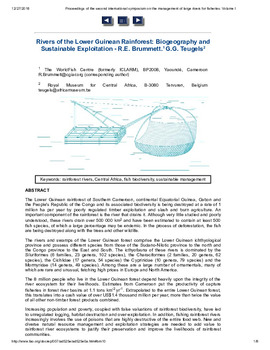Rivers of the Lower Guinean rainforest: biogeography and sustainable exploitation

Citation
Brummett, R.E.; Teugels, G.G. (2003). Rivers of the Lower Guinean rainforest: biogeography and sustainable exploitation. p. 149-172. In: Welcomme, R.L and T. Petr. (eds.) Proceedings of the Second International Symposium on the Management of Large Rivers for Fisheries, Phnom Penh, Cambodia, 11-14 February 2003
The Lower Guinean rainforest of Southern Cameroon, continental Equatorial Guinea, Gabon and the People's Republic of the Congo and its associated biodiversity is being destroyed at a rate of 1 million ha per year by poorly regulated timber exploitation and slash and burn agriculture. An important component of the rainforest is the river that drains it. Although very little studied and poorly understood, these rivers drain over 500 000 km2 and have been estimated to contain at least 500 fish species, of which a large percentage may be endemic. The icthyofauna of these rivers is dominated by the Siluriformes (6 families, 23 genera, 102 species), the Characiformes (2 families, 20 genera, 62 species), the Cichlidae (17 genera, 54 species) the Cyprinidae (10 genera, 79 species) and the Mormyridae (14 genera, 49 species). Among these are a large number of ornamentals, many of which are rare and unusual, fetching high prices in Europe and North America. A provisional list of the freshwater fishes of the Lower Guinean Ichthyological province is given as an annex. In the process of deforestation, the fish are being destroyed along with the trees and other wildlife. New and diverse natural resource management and exploitation strategies are needed to add value to rainforest river ecosystems to justify their preservation and improve the livelihoods of rainforest communities.
Permalink
Date Available
Type
Publisher
Copyright
CC BY 4.0
Topics
Language